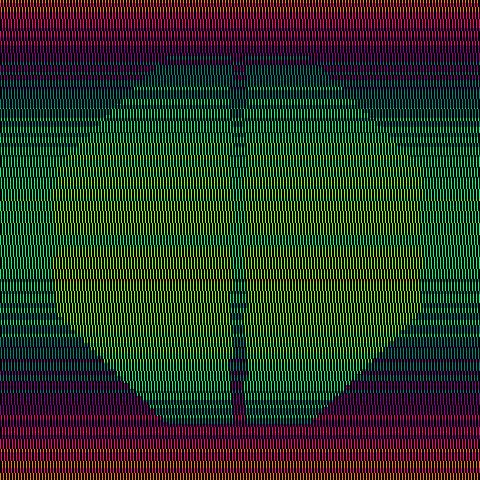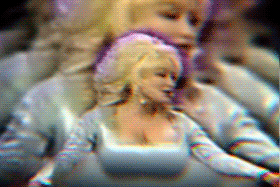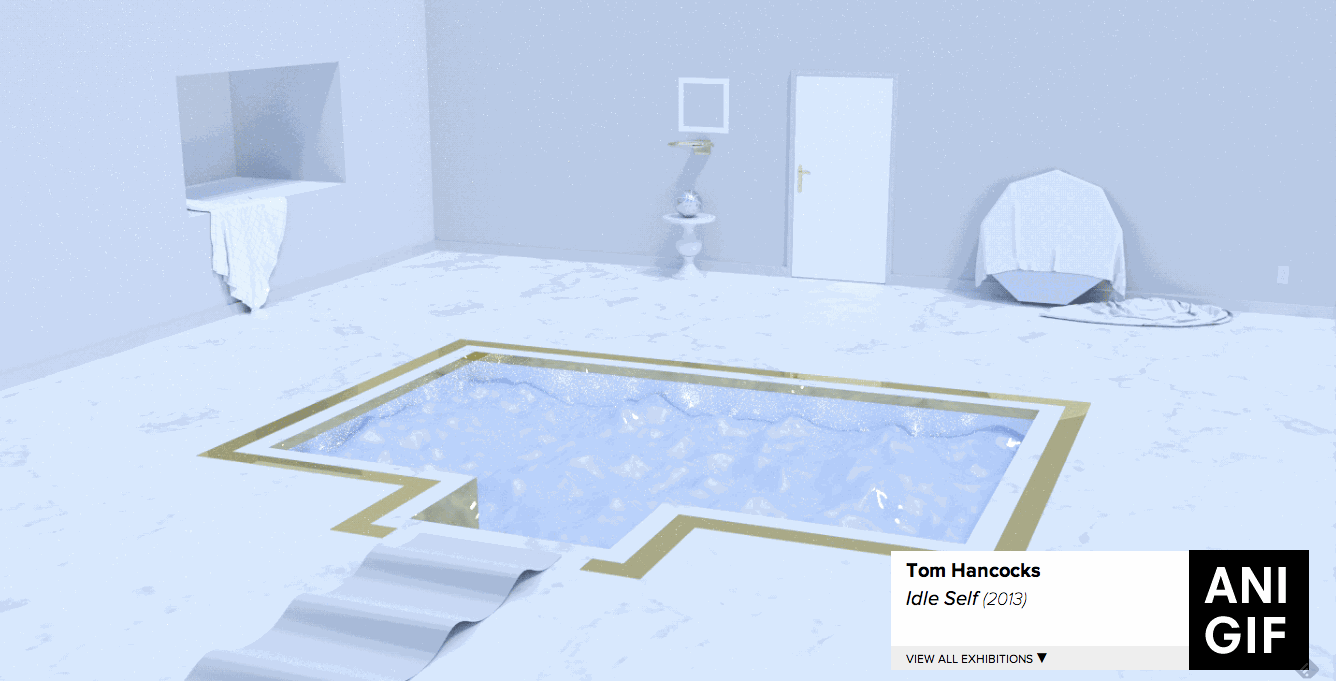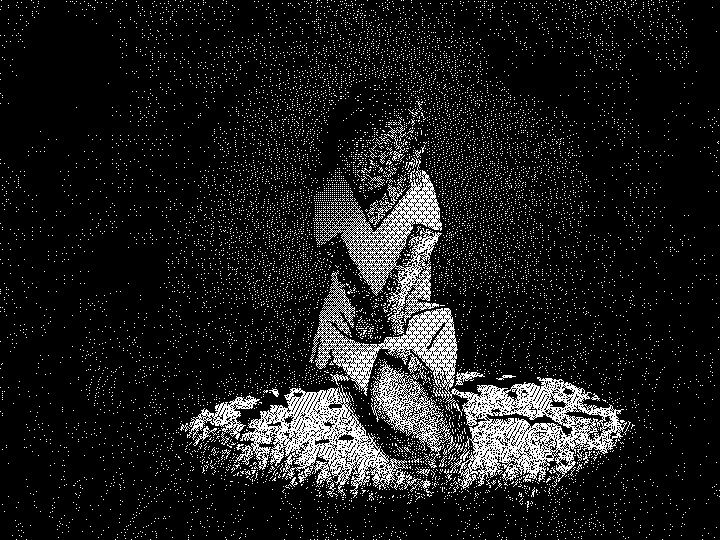Art & Exhibitions
A Brief History of Animated GIF Art, Part Four
From the Google+ golden era to the explosion of GIF exhibitions.

Courtesy the artist.
From the Google+ golden era to the explosion of GIF exhibitions.

Paddy Johnson

Welcome to part four of this brief journey through the rich history of one of the newest and most popular art forms, the animated GIF. The previous installments are “The Early Years: 1997–2008”, “Group Blogs, Surf Clubs, and the Beginning of Social Networking,” and “A Brief History of Animated GIF Art: Part Three, Tumblr.”
Much has changed in the world of animated GIF makers over the past few years. Social networking sites have become a lot more accommodating to larger GIF file sizes. Limited run online exhibitions have grown in popularity, as have brick and mortar events. As with the Tumblr history outlined in the previous chapter, there’s too much activity to document all of it. In this last section, I will outline some of the more seminal sites and exhibitions from between 2011 and 2014, as well as some very recent developments.
The most defining characteristic of these new GIFs are the larger file sizes, and the consequently increased amount of visual information they can contain. Additionally, whereas prior chapters in GIF art’s history have been dominated by developments in the North America and Europe, today’s GIF makers come from all over the world. That diversity of perspective has only increased the relevance and complexity of this art form.
Google+, 2011–present
In 2011, artists who made animated GIFs flocked to Google+. The site allowed users share large files, and as a social media network, it made it very easy to meet like-minded people. Artist Lorna Mills recently rattled off the names of no fewer than 17 artists she’d met through the network. They include Anthony Antonellis, Eva Papamargariti, Yoshi Sodeoka, and Giselle Zatonyl to name a few. Most were artists I was unaware of in 2011, but now see regularly; each exhibits their GIFs regularly.
As I reported earlier this year, 2011 was described as the “golden year” for animated GIFs on Google+. Now, almost no one uses the site any more. Apparently Google changed the network design frequently, and the column width became much smaller, making it a much less appealing environment for many artists, so they left.

Yoshi Sodeoka, Infinite Parton (2012).
Courtesy the artist, Sheroes.
Sheroes, 2011–2012
Energized by the activity on Google+, Sheroes was a series of monthly, limited-run art parties curated by Lorna Mills and Rea McNamara. At each party, artists were invited to make GIFs and other digital works in the likeness of a different famous woman. Often the events would take place in a bar or some other easily convertible space. Dolly Parton, Grace Jones, and Yoko Ono were each honored with projection-backed performances and installations.
This project was small at first, with only a few artists participating in early editions. But the Sheroes parties quickly expanded to host over 45 participants from around the world. It was the first GIF-centric event series of its kind.

Tom Hancocks, Idle Self (2013).
Courtesy the artist.
ANI GIF, 2011–present
This irregularly updated website lead by Daniel Rehn and Sarah Caluag invites artists to display a collection of GIFs in whatever way they see fit. The best versions of these projects use the platform to realize ambitious projects. Tom Hancocks’s Idle Self is a great example of this. The piece asks a viewer to navigate through rooms of GIF, each of which, from what I’ve been able to divine, represents a part of the psyche. There’s a fitness center in which a flowing carpet leads to a wave pool, a gallery in which a chain is run through a floating black gem, and a modernist living room with an undulating wood stove in the center. Each time the user moves to a new room, there’s a sense of accomplishment and fulfillment; just seeing the next GIF makes you feel as though you’ve done some self-exploration.
Not all the ANI GIF projects are so successful. Sylvain Sailly’s GIF of white pills and rolling logs on top of a yellow background is simple, but lacks the more satisfying bold graphic appeal of some of his other work. And Yoshi Sodeoka made a series of great psychedelic GIFs and then chose to display them in a cheesy rendered gallery. But for every failed project, there’s another so satisfying that you will keep coming back.
GIF ONLY EXHIBITIONS
Typically launched in conjunction with online events and discussions, there have been many brick-and-mortar GIF exhibitions recently. Just two weeks ago, the exhibition “GIF Free for All,” curated by A. Bill Miller and produced in conjunction with Computer Art Congress 4 in Rio de Janeiro, launched both online and offline. Online, that’s meant a single page that hosts all the curated work. Some of the GIFs have long loop cycles, the most notable being Giselle Zatonyl’s GIFs of slowly rotating beads and a glittering purple blob that moves like a desert snake in a Star Wars movie. Others are short, crisp loops. Laturbo Avedon’s falling paper trees and Rollin Leonard’s jiggling oil droplet or cell reflecting his face are both good examples of this and effective for entirely different reasons—Avedon for the formal satisfaction of the loop and Leonard for the sheer absurdness of giving a molecule reflective properties.
Even more recently Wallpapers, a collaborative project founded in 2011 by artists Sara Ludy, Nicolas Sassoon (see “How Nicolas Sassoon Is Making GIF Art Physical“), and Sylvain Sailly launched their second edition on Monday. The project will be showcased this weekend in a physical space at the New Forms Festival in Vancouver (September 18–21). Online, the show takes the form of a catalogue of artists’ digital patterns. Offline, the GIFs will be shown as projections scaled to the size of the exhibition space walls.

Peter Burr, from the “Fills” series (2013).
Courtesy the artist.
“The Wrong, New Digital Art Biennale,” 2013
The size and scope of this exhibition is so enormous, I’m still amazed that it even exists. Conceived and organized by David Quiles Guillo, the founder and director of the Sao Paolo-based independent creative organization ROJO, it brings together 30 curators, each of whom assembled one exhibition with 10 or more invited artists.
The digital exhibitions were hosted on “pavilions” or individual websites and linked by way of the main biennial website. Meanwhile, offline events promoting the biennial took place at IRL “embassies” such as Transfer Gallery in Brooklyn and Paradise Hills in Melbourne. With a total of 13 physical locations and over 300 participating artists, the show ran three months in all.
It was an amazing, enormously ambitious project designed to showcase digital art, so naturally GIFs carpeted many pavilions. Though the main website no longer links to the pavilions many are still live, including Yoshi Sodeoka’s tour de force Plan 9 Channel 12. Simon Stage’s black and white geometric abstractions and Peter Burr “Fills” series—black and white patterned landscapes created with the Photoshop fill tool—remain highlights for their graceful loops and seemingly infinite variation.
BONUS: The Opening Times Residency Program
This is a new UK based online residency we expect to see a lot of GIFs come out of, if for no other reason than, many artists who work online also make GIFs. For their first residency artist Nicholas Sassoon created browser-sized GIFs for his series, “Pandora.” (I talked to Sassoon about the residency here on artnet News back in July.) May there be more residencies like this one.
ADDENDUM: Computers Club, 2007–present
Computers Club founder Krist Wood describes it as a “digital sculpture,” a composite artwork shaped by the identities of its contributors. All members have been invited by Wood, and new members are rarely added. Basically, it’s a collaborative art blog with a green rotating splash page and no visible publishing dates. According to the members page, Computers Club has 19 members.
Unsurprisingly, the blog has hosted seemingly countless GIFs over the seven years it’s been running. Recent images tend to be supersized, but they already tended to be large back when the site launched. Artists usually post their own work.
The Computers Club Drawing Society works differently. Artists are encouraged to apply for membership and invitations are periodically given out. There is a communal set of digital drawing tools members can use to make images, and they are shared on a public page. Most posts draw one or two comments from artists, typically expressing appreciation for the work.
Computers Club Members: Sage Keeler, Petra Cortright, Alexandria McCrosky, Daniel Williams, Matthew Wrath, Laura Brothers, Robert Lorayn, Krist Wood, Rene Abythe, Nicolas Sassoon, Sara Ludy, Duncan Malashock, Travess Smalley, Rafael Rozendaal, Alexander Peverett, Kathleen Daniel, Sabrina Ratte, Elna Frederick, Angelo Plessas and Wyne Veen. (This entry has been added to the chronology in part 2 of the animated GIF history.)